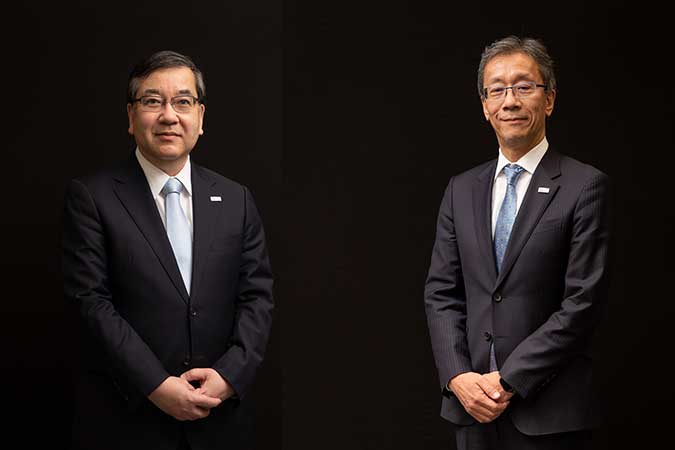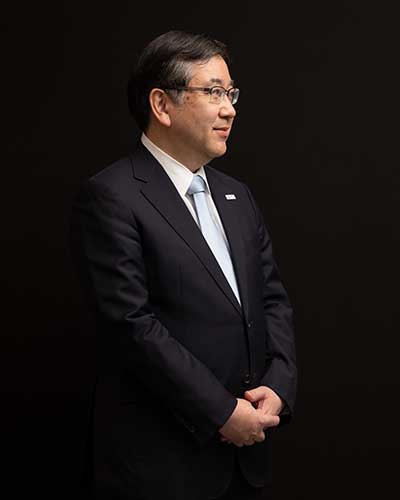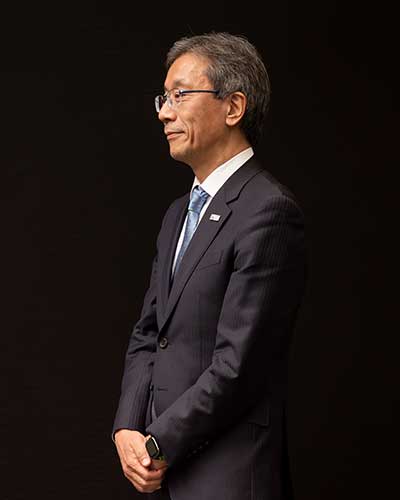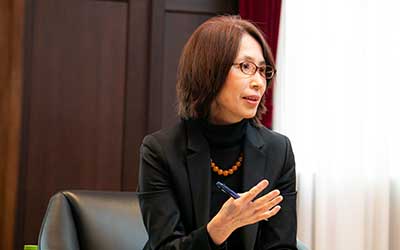Passing the baton of knowledge collaboration The sitting president and the incoming president discuss the last six years and the next six years

Passing the baton of knowledge collaboration
President Makoto Gonokami, who is about to finish his term, spoke with Executive Vice President Teruo Fujii, who is set to succeed him as the president of UTokyo. Professor Fujii is a like-minded colleague who has helped to advance reforms intended to streamline the University as a true management body. There is no one better suited for a discussion about UTokyo’s past and future.
Moderating this dialogue between a sitting and an incoming UTokyo president – a first in the twenty-two-year history of this magazine – is Executive Vice President Sawako Shirahase, who has also exerted tremendous effort on behalf of the University alongside the two participants. As you read this piece, we invite you to call to mind the passing of the baton of knowledge.
Formulating a vision through a cycle of “top-down” and “bottom-up” communication
- Shirahase: At a roundtable discussion that took place in March 2016 (Tansei issue 32), President Gonokami, you said that you had discussed intensively with your colleagues about the guiding principles for the next six years. To begin with, I want to ask you how you proceeded with discussions and announced their results as The University of Tokyo: Vision 2020 in October 2015, as well as what you were thinking at the time.
- Gonokami: I prepared the draft in discussion with other members of the University, including Professor Fujii, and then polished it further after hearing views from the departmental chairs at the Council of Deans and Directors. This was because I felt that these guiding principles could not succeed without buy-in from the entire University. At the time of the announcement, I published my own thoughts as to what I wanted to say in the Vision as a separate paper, titled “Announcement of The University of Tokyo: Vision 2020.” For example, there is a passage stating, “the limitations of the basic systems supporting modern society, such as capitalism and democracy, have become obvious.” Initially, I included this in the text of the Vision document, but decided to remove it after it was pointed out to me that writing that might be going a bit too far. Likewise, I also stated in this announcement that “it is vital that we depart from conventional ideas and change how the University of Tokyo is managed and operated.” At the time, a lot of members of the university were still reluctant to use the word “management” in documents intended for the University as a whole.
- Fujii: You intentionally did not use the word “management” in the final document.
- Gonokami: Even in that prefatory “Announcement,” I restrained myself to that phrase, “how the University of Tokyo is managed and operated.” Indeed, where I wrote “we must equip the University with the ability to act independently” I was implying a shift “from operation to management.” We devoted our efforts to refining those points that could be shared across the entire University. After formulating the document, we arranged Q&A sessions with faculty councils in all of the departments concerning how we might proceed with the Vision. I was always conscious of creating a feedback loop through top-down and bottom-up communication.
- Fujii: We devoted our efforts to expressing the president’s thoughts in a universal manner. At the time, the figure that emerged when we reviewed the materials featured the planet, the public nature of knowledge, UTokyo, diversity and excellence. Although the term “sustainable development goals” (SDGs) did not appear, the content was very much in line with the SDGs. The section that takes up ways of conceptualizing global society in the twenty-first century to discuss the public role of the University in spatial and temporal terms is associated with a sense of crisis that urges us to act now. We felt that future economic growth must be predicated on due consideration for the environment.
- Shirahase: Professor Fujii, you are the first one to bring up the term “public role” at this roundtable.
- Fujii: Our main premise was that universities had to contribute to the global public sphere. Although the components of the figure just mentioned were phrased as “21st century Global Society,” the creation of a new public role is something that the University should aim toward. This idea of creating a new global public role in collaboration with actors outside the University, rather than simply at the level of universities alone, was one that was shared by the president and the other members of the drafting committee from an early stage.
- Shirahase: On that note, I feel that the promotion of collaborations between the University and industry has been one of President Gonokami’s most significant achievements. Could you tell us more about what the comprehensive collaboration between these two types of organizations means in a real sense?
A new style of collaboration with industry emerging from discussions with business leaders

Makoto Gonokami
Took office in April 2015 after serving as professor in the Graduate School of Engineering, professor in the Graduate School of Science, and dean of the Graduate School of Science. A specialist in quantum optical physics. His Japanese publications include Henkaku wo Kudou suru Daigaku (“The University as a Driver of Transformation”; University of Tokyo Press, 2017) and Daigaku no Mirai Chizu (“A Future Map of the University”; Chikuma Shinsho, 2019); Atarashii Keieitai to shite no Tokyo Daigaku: Mirai Shakai Kyoso e no Chousen (“The University of Tokyo as a New Type of Management Entity: The Challenge of Creative Collaboration for the Future ”; University of Tokyo Press, 2021).
- Gonokami: After I took office, I had more opportunities to talk with the top leaders in various industries, and I took hints from the fact that they told me that it was not clear for them where to invest. In the background here is my experience of involvement in a COI* project dealing with photon science, which began before I took office as president. I found that the reason many conventional joint research projects with industry partners are small in scale is that corporations lack the authority to approve large budgets at the level of the departments that serve as the contact points for the collaborators. Accordingly, I felt that the only way to move forward with large-concept joint research projects was to secure agreements with top management directly. In normal joint research contracts, research costs are determined by the total amount of expenses necessary for the enterprise. In such cases, the value of the knowledge produced by the University is considered effectively nil. Accordingly, I realized that we should firstly reach executive-level agreements on organization-to-organization collaboration, and then work together to think about where to invest, and draw up a suitable contract on that basis.
However, UTokyo’s system was too fragile to accomplish that. We had no experts who were up to the task of drawing up contracts that considered the individual circumstances for each case. All we could do was to select from among two or three templates and then force them to fit the application. We decided to strengthen our intellectual property department with the sufficient deployment of qualified legal professionals. Although it took us two to three years, we were finally able to get something firmly in place. - Fujii: Prior to taking up my executive post in the fourth year of President Gonokami’s term, as the director of the Institute of Industrial Science (IIS), I had been promoting comprehensive collaboration with the corporate sector on the part of the Institute as a whole. I remember being told by President Gonokami at the time that he wanted to engage in “real industry-academia collaboration.”
- Gonokami: As an executive vice president, Professor Fujii, who had been the director of IIS, which could be said to be our hub of collaboration with industry, brought to the headquarters the projects that were too large to proceed with at the research institute level alone. Many of these were quite ambitious, but in those first three years, I had managed to set up a system in which even these could be accommodated.
- Fujii: Industry-academia collaboration is something that cannot move forward without building up solid relationships both at the executive level and among the teams that actually carry out the work. This was something I paid particular attention to as the executive in charge.
- Gonokami: Professor Fujii pioneered many projects after becoming the director of the Division for External Relations. One of these was the collaborative arrangement we reached with Tata Consultancy Services (TCS).
- Fujii: TCS is a top-tier company in the digital technology sector, and is extremely important when thinking about the relationship between Japan and India. I felt that for UTokyo, which is engaging in digital transformation (DX), to join forces with TCS would have benefits for society as well.
- Shirahase: I hear that Professor Fujii was also a key person in achieving a collaborative agreement with TSMC*.
- Gonokami: When I traveled to Taiwan on business in December 2018, I had the chance to consult with Morris Chang, the founder of TSMC, who is also a member of the UTokyo Global Advisory Board. I had visited TSMC in 2014 in connection with the COI photon science project, at which time I had felt that UTokyo should collaborate with TSMC. However, since Dr. Chang had retired in the summer of 2018, he recommended that I talk to his successor, Mark Liu. Although I’d never met Dr. Liu myself, it fortunately turned out that he was already an acquaintance of Professor Fujii.
- Fujii: That September, taking part in a forum that was being held in Kyoto, I happened to be seated next to Dr. Liu, and said that I hoped to be able to visit him next time I was in Taiwan. I conveyed to the president that Dr. Liu had given me his contact details so I could get in touch with him.
- Gonokami: So I suggested that we could go together. Although we had not made any advance arrangements, we came straight out with a proposal to collaborate on the latest semiconductor process technology. Since it was not far from my own specialty, I focused on the technical and strategic aspects rather than talking about things in general terms, and we ended up deciding on the spot to work together. In business, TSMC has a reputation for being difficult to work with, but owing to the esteem they had for the University of Tokyo, the discussion went ahead smoothly.
- Fujii: I feel that the academic connections that we have built up in the semiconductor field were effective.
- Shirahase: Regarding the expansion of a global network, would you say that our alumni can play an even more important role in the future?
- Fujii: External relations also includes relations with our alumni. It is extremely important that UTokyo’s philosophy and efforts strike a chord with society at large, and that includes our alumni.
- Gonokami: We incorporated the Division for University Development, which had been in charge of donations, into the Division for External Relations, and asked Professor Fujii to serve as the executive in charge. This was an important reorganization. In the past, even when everyone made their best effort individually, we had never reached the point of being able to exert our strength as an organization. That has now changed dramatically.
- Fujii: The Division for University Development and the Alumni Office, which had been working independently, were both placed within the Division for External Relations. Up to that point, my calls for donations when I attended alumni functions were sometimes met with a cool reception, and I would be told that “This is not the place for soliciting donations.” But by continuing to carefully explain how the money is needed for the University’s social contributions, I feel that circumstances in that regard have begun to turn around.
- Shirahase: On another note, UTokyo underwent an evaluation to be named a “Designated National University” in 2017. Could you tell us what happened at that time?
- Gonokami: I laid this out clearly at the time as a shift “from operations to management,” and there was no one on campus who disagreed with that. However, our idea of foregrounding SDGs proved to be more unpopular with the MEXT examination committee than we expected. One of their criticisms was that we were being too all-encompassing, and they wanted us to narrow it down to specifics. Unlike other universities, the University of Tokyo emphasized the idea of making use of the University for the future of the planet and of human society, but this may have seemed like a lot of hot air to the examiners. But at the time I was being earnest. The examination committee also included members from overseas, and ultimately UTokyo’s initiative received a positive evaluation and we became a Designated National University. In order to put the initiative into practice in a timely manner, the current Future Society Initiative (FSI) was launched in the summer of 2017 as an organization positioned directly under the president. Professor Fujii has been playing an active role in the FSI. I believe he was also responsible for designing its lapel pin.
An initiative spreading from the idea of a lapel pin that piques curiosity

Teruo Fujii
Appointed in April 2019 as an executive vice president (in charge of finance, external relations and industry-academia-government collaboration) after serving as a professor and then director at the Institute of Industrial Science. He specializes in applied microfluidic systems. His hobbies include swimming and jogging.
- Fujii: The president told me to establish a fund to support FSI, but the idea of this lapel pin was in my mind from the very beginning. I thought we might be able to create a virtuous cycle by distributing these to donors and, through the lapel pins, raise awareness about their efforts alongside the University of Tokyo to contribute to the future of the planet and human society.
- Shirahase: When I wear my lapel pin, I have been frequently asked what it is.
- Fujii: I felt that getting people to ask us about it would be the first step toward realizing UTokyo’s initiative.
- Gonokami: That November, the Japanese Business Federation (Keidanren) revised its Charter of Corporate Behavior to highlight SDGs and Society 5.0. A leading business organization had altered course, and this took the form of lending its support to the University of Tokyo’s initiative.
- Shirahase: I believe alumni are very helpful for making the message known widely and can play a critical role to expand it.
- Fujii: The University’s two graduate associations, namely the UTokyo Alumni Association and the University of Tokyo Regional Alumni Association, have been trying to join forces to work together.
- Gonokami: The members of the two associations have told me that they have given serious thought to uniting during my term in office. A memorandum of understanding was signed in March 2019, and last October the first stage of unification began in the form of a cross-appointment in their secretariats. At the end of last October, I spoke with Akito Arima, who was chairman of the Regional Alumni Association. Sadly, this proved to be the last time I would see Dr. Arima [who died last December], but I am happy that he was able to witness the resolution of this question.
- Shirahase: The final stage of President Gonokami’s term of office was marked by a serious challenge against the COVID-19 pandemic; extra efforts had to be made to cope with it, and we are still in the middle of the situation.
- Gonokami: Throughout my term, I was constantly trying to promote the transition to a knowledge-intensive society through the use of DX, and you could say that was good preparation in terms of our response to COVID-19. Even so, the foundation of the University’s activities is the generation of wisdom while engaging in face-to-face discussion. I am all too aware that there is a limit to how much communication can be achieved through a screen. The Committee of Advisers to the President is symbolic of this. This system, in which enterprising faculty members are selected from the University’s organizations to serve as advisers to the president and work from the perspective of the administration, is also meant to be an opportunity for faculty members to grow. There are some things that can be refined by confronting challenges face-to-face with the executive administration. This year’s members have also worked extremely hard during the coronavirus pandemic. However, without the opportunity to meet in person, I feel that they may not be able to enjoy the “cultivated sense of accomplishment” that members normally feel at the end of the year. I imagine the same sort of thing is also occurring in other settings. There are limits to what can be accomplished working solely online, and I am concerned that the University is not functioning to its full potential. And given the fact that activity restrictions are dragging on, I feel that the time is coming when we will need to make a major change in our way of thinking about how to deal with the situation.
- Shirahase: We are all suffering from this very unusual experience, including faculty and students alike. There is a concern that polarization in various aspects of society has taken place and it could lead to making society further divided. Professor Fujii, how do you feel about assuming the presidency during this time?
- Fujii: Academia has to keep its eyes on looking for solutions. It’s no good to give up simply because we cannot do something. It’s important to figure out ways of working within our limitations. In that sense, the Virtual UTokyo* project that took place at last year’s Open Days event is a good example. I would like to foster similar attempts throughout the University.
- Shirahase: The University president is required to make large and serious decisions. For example, this year President Gonokami decided to implement the academic calendar without rescheduling the new semester under the current COVID-19 pandemic.
- Fujii: I expect the time will come when I, too, will be called upon to make important decisions. As president, I feel that the first thing I will be required to do is decide which areas of the University to invest our resources in.
A president must sometimes make decisions alone

Sawako Shirahase
Appointed in April 2019 as an executive vice president (in charge of international affairs and public relations for the president’s vision) while serving as a professor at the Graduate School of Humanities and Sociology. Her major is sociology, specializing in social inequality and demography. Her books include Social Inequality in Japan (Routledge, 2014) and Ikikata no Fubyodo (“Inequality in a life course,” [Japanese], Iwanami Shinsho, 2010).
- Gonokami: In a way, I was fortunate that the coronavirus pandemic struck during the final year of my term. Although I was often forced to make difficult decisions on the spot, this was something I was able to do because I had already accumulated a store of trust both inside and outside the University. I think it would have been quite difficult to manage if it had been during my first year. Something I learned while assisting past presidents is that there are some things that a president has to make decisions about on their own. In a sense, the president is alone. They may have colleagues, but no one else is in the same position. Here, I feel that coming to a clean decision is the only way.
- Shirahase: There is still room to achieve diversity in the University of Tokyo. For instance, the number of female undergraduates remained quite underrepresented in our University during President Gonokami’s term.
- Gonokami: Unfortunately, the University of Tokyo is far from ideal in terms of inclusivity. However, this also means that the pursuit of diversity is where the University has the most potential. It is important that UTokyo, which is lagging most of all in terms of the proportion of female undergraduates, should continue to demonstrate actions leading to the creation of a society that is conducive to active participation by women. When we talk about the current situation at UTokyo to people overseas, we are told that it is “unhealthy.” Although I have also come to realize this while serving as president, this feeling has yet to penetrate the entire University. That is the biggest challenge.
- Fujii: I feel that I will have to take on that sense of crisis and move forward. Finding positive value in expanding our activities while taking inclusivity into consideration is of the utmost importance. I would like to position this as a key concept in the guiding principles I set out as president.
- Gonokami: Last June, I took part in a session of the UTokyo Women’s Zoom Café in which I talked with female students, and I felt that the event was a positive development coming out of the coronavirus pandemic. It may be difficult for many of us to gather at Yasuda Auditorium, but with Zoom we can take part with ease. I felt as though I was able to speak to people directly, even though we were separated by a screen.
- Shirahase: I saw that the number of students who have been able to speak directly with the president has increased, which was a satisfying experience for them. Do you have any thoughts on this, Professor Fujii?
- Fujii: I would say that we should also have discussions with male students. And in terms of diversity, I would also like to speak with our international students.
- Gonokami: You will need to decide how you are going to spend your limited amount of time, but I would say that is something that is definitely worthwhile.
- Shirahase: As I am assured that both of you show strong intentions and wish to improve diversity in the University of Tokyo, it is about time to close this dialogue. This is quite encouraging for all of us. Once again, President Gonokami, please accept our sincere gratitude for your efforts and what you have done over the past six years as the president. And Professor Fujii, we wish you the best of luck in your new term as president of the University of Tokyo.
(This dialogue took place on January 22, 2021.)
Photos: Junichi Kaizuka
* COI: Center of Innovation, a program by the Ministry of Education, Culture, Sports, Science and Technology (MEXT) supporting innovative research and development on a ten-year time horizon.
* TSMC: Taiwan Semiconductor Manufacturing Company. The world's largest semiconductor manufacturer.
* “Virtual UTokyo”: A project in which a 3D-computer graphic model of Hongo Campus made by student volunteers can be freely accessed using a smartphone or PC. The model also features active participation by the 3D avatars of President Gonokami and Executive Vice President Fujii.
** This article was originally printed in Tansei 42 (Japanese language only). All information in this article is as of March 2021.






